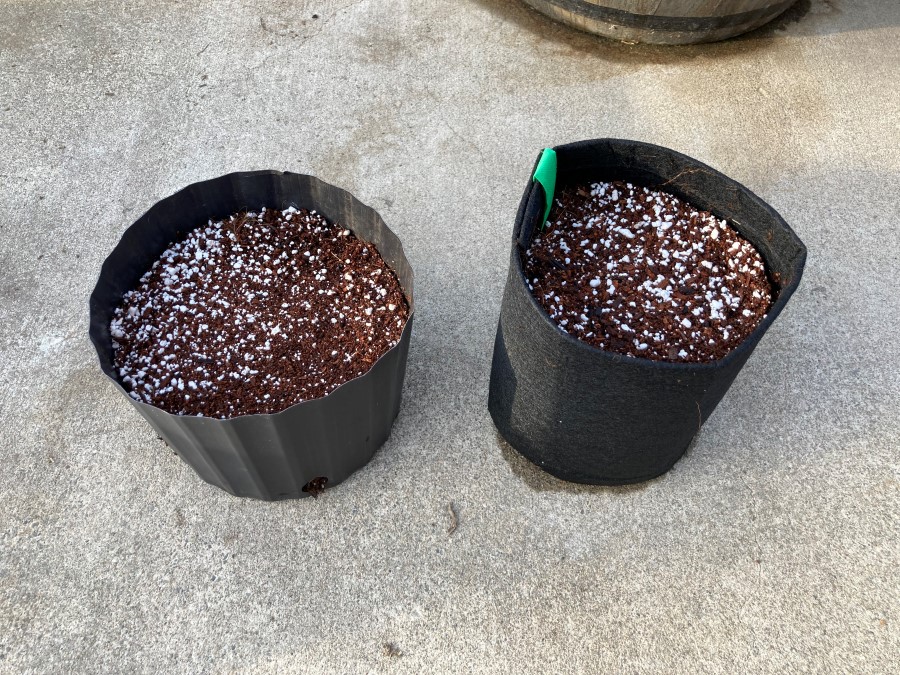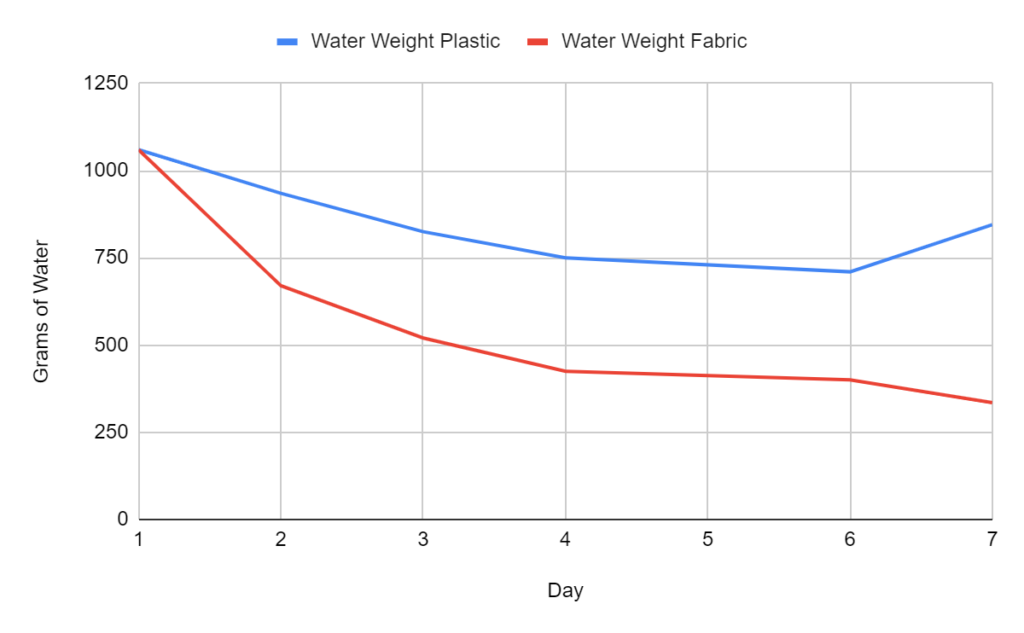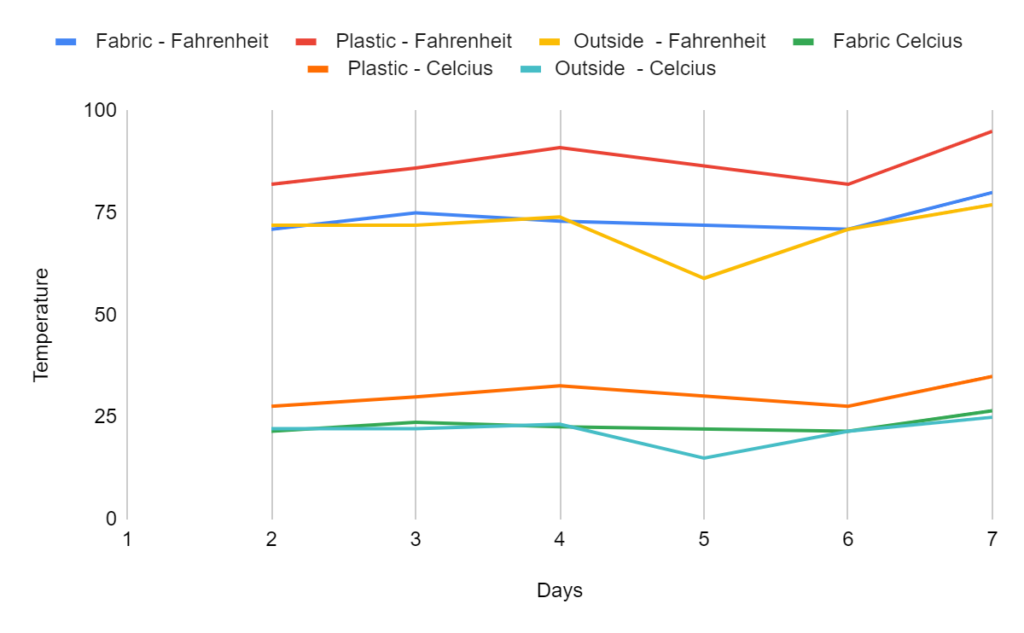
Fabric pots are cheap and easily folded and stored in a small space when not in use, but I have noticed that when I use fabric pots I water those pots more frequently. I may just be thinking that I am watering more, or that the soil dries out quicker, but do they actually use more water than a plastic pot?
Fabric pots do require more water than standard plastic pots. This is do to the soil within the pots having a larger surface area exposed to the air via the porous fabric that surrounds the soil as well as the soil surface. This allows faster evaporative loss compared to a standard plastic pot where evaporation occurs mainly at the soil surface.
I conducted a little test to see how fast and how much water was lost through the use of a fabric pot. I noticed some things about fabric pots that made me wonder if they are worth using.
Do they use more water than plastic pots?
I have noticed for many years that I need to water fabric pots more than standard plastic pots. This may not be much of an issue in places that have a higher humidity, where it rains more, or where water is more plentiful. I live in California in an area that gets an average of 38.1 cm (15 inches) of rain a year. Almost all of which is in the winter. So water is important here, especially in the hottest parts of the year when average daytime temperatures reach 32.8° C (91° F) and there is no rain at all.
I decided to run a little test to see how much water is actually lost compared to a standard plastic pot.
A 1 gallon fabric pot lost 37% of the water by weight contained within the growing medium in a 24 hour period. While a plastic pot of the same size lost only 12% water, and took nearly a week to lose the same amount of water.

As you can see from the chart a fabric pot (Red Line) loses water at a much faster rate than a plastic pot (Blue Line). This is for a 1 gallon pot though, a larger or smaller pot will differ.
On the 4th day of the test you can see that the water weight did not change very much and that is because it rained that day so I moved the pots under cover before they got wet.
On day seven the water weight goes up for the plastic pot which had me puzzled for a few minutes until I realized a trail of water had run down the concrete to the pot. The potting soil in the pot then wicked up water and increased the weight.
I decided to stop the test at this point because the test had been compromised, and I really didn’t need any more data. The fabric pot lost 37% of its water in the first 24 hours, that is crazy.
The last day may have been ruined by me watering another plant and not realizing a trail of water was running down to the plastic pot. It is clearly seen from the graph, that water weight up to that point was decreasing every day for both pots, and the water loss in the fabric pot was considerably higher than the plastic pot.
I also found a study done on plant growth in plastic pots vs alternative pots called Multistate Evaluation of Plant Growth and Water Use in Plastic and Alternative Nursery Containers. In this study they found that alternative pots, which includes fabric pots, used more water than standard plastic pots.
Reasons grow bags may use more water.
Fabric pots used in areas of high moisture either through rainfall or humidity, or both can be a good idea. In areas of low moisture, high heat, wind, or any combination of the three may need to be thought about a little more carefully as the water loss is so high. Why is the water loss so high though.
Soil within fabric pots has more surface area where water can evaporate compared to standard plastic pot. Evaporative loss in standard plastic post occurs mainly at the surface on top, while fabric pots have evaporative losses on the top of the soil and the entire circumference of the pot
Not only does water evaporate from more surface areas but water can also be wicked away from the pot. For instance, if the fabric pot is on concrete or soil the water will be wicked into the fabric and then wicked into the soil or concrete (Get a picture).
If the side of the fabric pot is touching a wall, another pot, or anything else, water can potentially be wicked out that way as well.
If the soil or potting mix dries out to much it can start to form a crust, and this crust can become hydrophobic, meaning it repels water. This tends to happen to me more in soils that are peat based, and I have had almost no problem with coconut coir based soil mixes.
This hydrophobic area on top will cause water to run to the sides of the pot, and in the case of a fabric pot pour out the side of the pot, and almost all the water has been wasted. This can also happen in a plastic pot but at least some of the water will be absorbed as the water moves down the wall of the pot and then out the drain holes on the bottom
Potting mixes can and will shrink as well which will cause similar issues to the one above. In this instance a gap forms between the soil mix and the side of the pot, allowing water run down the gap and out of the pot. This will happen in a plastic pot as well, and the water loss will probably be about the same as the water runs straight down the side and out the bottom.
How to conserve water in a fabric pot.
If fabric pots use so much water you might be wondering how to save water in a fabric pot if you have one or if you plan on using one. I use a few techniques to save water with fabric pots, and I am sure there are many, many more. Lets take a look at a few though.
A fabric pot placed in a saucer will allow any water that has run through the potting soil or out through the side of the fabric pot to pool in the saucer. This water can then wick up in the fabric pot and then into the soil. As the soil dries out the saucer will act like a reservoir for the pot, and more water will be wicked up as needed until the saucer dries out.
Placing mulch on top of the soil in the pot will also help keep water in by limiting evaporative losses through the soil on top. The soil on the sides will still have considerable loss from evaporation but this can also be limited.
To limit the amount of water lost through the sides of the pot make sure direct sunlight does not shine on the pot itself. More importantly, at least in my area may be to create some sort of barrier that will block the wind from blowing on the pot directly.
If you have other potted plants that are in standard plastic pots you may want to place those on the windy side to block some of the wind. Or if you have many potted plants bunched together, you can put the fabric pots in the middle so wind and sunlight don’t directly blow or shine on the pot.
Temperature of soil in a grow bag.
This is one I didn’t really think of until I was running my test. I did know my plastic pots and even the plastic garbage cans I grow in (bins as some of you might call them) get very hot and so does the soil inside. I didn’t know how hot the soil would get in a fabric pot though. Luckily I did think of this right when I started so I was able to get the temperatures throughout the test with a temperature probe starting on day two.
Fabric pots in the test were on average 7.36° C (13.2° F) cooler than plastic pots. A larger difference in temperature was observed on warm days than on cooler days. Indicating that fabric pots may be beneficial in hot areas or during hot weather in preventing root damage.

As you can see from the temperatures in the chart, using a fabric pot keeps the soil considerably cooler. This is probably do to the fabric pot acting like and insulation layer, like insulation in a home or a thin layer of neoprene that a wetsuit provides.
Day 5 the pots were sheltered because of rain so I didn’t take the temperature that day. It was probably equal to the ambient temperature outside. That is not the point of this, anyone can make stuff up, and they do.
Another reason it probably stays cooler, and this might be the biggest part, is the water evaporating from all the surface area that fabric pot provides.
So if you live in a hot area, and need to keep the roots cool, and you can spare the water, fabric pots may be a pot to look into.
